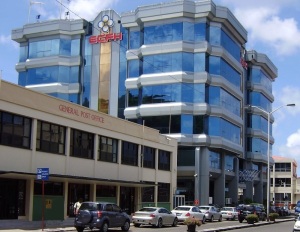 For years, productivity was a term reserved for the esoteric conversations of academics, of little interest to anyone else, but no longer. Within recent years productivity has been at the forefront of the discussions of policy-makers, politicians and even the lay-man. The latest (2008) financial crisis and the period of hardship which ensued have exposed the vulnerabilities of Caribbean economies of which low growth and high debt top the list. This has prompted policy-makers to take a closer look at productivity and evaluate its relevance to the region. It is the belief that the Caribbean’s comatose growth is a symptom of the region’s low productivity. Barbados’ Prime Minister the Hon. Freundel Stuart previously admitted that Caribbean economies have been lagging behind in initiatives intended to boost productivity levels and drive the region’s trade competitiveness and economic development.
For years, productivity was a term reserved for the esoteric conversations of academics, of little interest to anyone else, but no longer. Within recent years productivity has been at the forefront of the discussions of policy-makers, politicians and even the lay-man. The latest (2008) financial crisis and the period of hardship which ensued have exposed the vulnerabilities of Caribbean economies of which low growth and high debt top the list. This has prompted policy-makers to take a closer look at productivity and evaluate its relevance to the region. It is the belief that the Caribbean’s comatose growth is a symptom of the region’s low productivity. Barbados’ Prime Minister the Hon. Freundel Stuart previously admitted that Caribbean economies have been lagging behind in initiatives intended to boost productivity levels and drive the region’s trade competitiveness and economic development.
There is an urgent need for the Caribbean to undergo a period of introspection with the intention to identify the root of our low productivity and putting forward ideas and policies to remedy this deficiency. This article is one such attempt at self-examination, but is by no means a complete diagnosis of the regions deficiency. Rather, the article is a mere snapshot into the Caribbean’s low productivity which will hopefully inspire further discussion. The article will look briefly at the cause, effect and solutions to low productivity within the Caribbean; not necessarily in that order.
A good starting point for this review is perhaps to define productivity. The simplest definitions is that productivity is the rate within which inputs can be converted into output. The higher the conversion rate of inputs to output the more productive an individual, organisation or economy.
As was established above, low growth is one of the side-effects of low productivity. In order to appreciate the seriousness of low growth we shall consider the following. In the 1960s income per capita in Latin America and the Caribbean was almost one quarter that of the United States; compared to present day income per capita which is a mere one-sixth of the United States of America’s income per capita. This can be juxtaposed against East Asian countries which in the 1960s had income levels well below those of Latin America and the Caribbean; now, these very same countries are fast approaching the income levels of developed countries. Had productivity in the region grown at-least at the same rate as the United States of America, the income per capita of the region relative to the United States would have remained roughly at one-quarter after 50 years. Instead, our income per capita has worsened considerably in relation to the United States of America and many other economies and regions globally.
Within the Caribbean we have paid dearly for our lack lustre economic growth which has resulted from low productivity. One side effect which comes to the fore is rising public debt. Since, our growth within the region has been constrained, occasionally we are forced to borrow to survive; not only to cover capital projects but at times we borrow to meet recurrent expenditure.
One response taken by most Caribbean nations at one time or another to combat low growth was the provision of tax incentives to attract foreign direct investment, with the intention of increasing activity within the respective country and thereby propelling growth. These measures although well-intentioned can be harmful in the long run. For example from the 1970s and 1980s Jamaica’s industrial policy was based on two pillars: granting tax incentives to attract foreign direct investment and export promotion. This has resulted in a complex system of tax incentives which has distorted the country’s structure of taxation. Jamaica’s tax system consists of over 200,000 different incentives all in the name of attracting foregn direct investment; unfortunately, these incentives on average result in the government forgoing approximately 20% of its annual revenue. This lost revenue again leads to state borrowing, but also robs citizens of revenues which could have otherwise gone into infrastructural development, healthcare, education and any other number of causes.
The effects of low productivity are felt not only by the state and policy-makes, but also by the common man. Low productivity countries will normally have a lower standard of living and a more diminished quality of life in comparison to similar countries which enjoy higher levels of productivity. This is evident from the differences which would arise in income per capita from the above example; if using this as a proxy for standard of living. Eventually the population will realise the inability of the state to provide the quality or extent of services that more productive countries are delivering, which then results in a diminished sense of wellbeing and quite possibly migration in search of more lucrative opportunities. Once again this scenario is representative of the Caribbean, where in previous decades entirely families uprooted in droves en-route to the developed world in search of a better life.
Of-course there are a number of other side effects from low productivity, apart from the few mentioned above, but brevity must take precedence. The root causes of low productivity are just as sobering as the effects. If the question of “What causes low productivity within the Caribbean” is posed to the average Caribbean citizen he or she may not hesitate to finger the government or the laziness of Caribbean people. However, the causes of the deficiency are far broader and extend well beyond the bad habits which we have adopted as a society.
Poor allocative efficiency can be credited as the overarching causes of low productivity within the region. What this means is that the allocation of resources within the region has been or is being done in such a way that the maximum benefit from resources is not being obtained, resulting in Caribbean individuals, firms and governments paying a premium for lost output as a result of input resources not being assigned to where they would provide the highest value and return.
One infamous example of allocative inefficiencies across the region is through government social policies; either through government spending or regulation. ‘Blanket policies’ which are not properly implemented or monitored can have unintended consequences to the detriment of the economy. For example short term government employment programmes in Trinidad & Tobago have paid wages above the market rate for unskilled workers. This has resulted in an influx of applications for those programmes, resulting in a large number of unfilled vacancies for unskilled positions such as cashiers, cleaners and store assistants. This may seem innocent, but the impact is that salaries for these positions must then be raised to compete with government short term employment programmes and attract suitable labour, thereby unnecessarily increasing the cost of operations and making output less competitive regionally and or internationally. Social policies if left unchecked (as has been done in the region) result in a far greater cost, than just the funds allocated for these programmes. This is just one example of a well-intentioned social programme having adverse side-effects.
Interventions in the labour market by trade unions and other stakeholders can also hamper productivity, by preventing the efficient allocation of resources. Sometimes, these interventions may seem like a necessity, but this may be far from actuality. One prominent example is the upwards negotiations of wages solely on the basis of the increasing costs of living. Employees who are deserving of wage increases certainly should not be denied of such, by no means is this being suggested; however, rising costs of living may not be the most suitable benchmark to determine whether increases are necessary. Increased profitability of private companies and noteworthy performances are more appropriate criteria for determining wage increases. When wages and salaries increase solely in response to the cost of living, this increases a company’s cost of operations, without any increase in revenue or returns, therefore making operations less profitable, competitive and more expensive. The ultimate result will be a reduction in the demand for the goods and services of this company, possibly, with the eventual shutdown of the company, a fate which could have otherwise been avoided. Perhaps, this is why the Caribbean is one of the most expensive tourist destinations globally, and not because of the loss of economies of scale due to our smallness.
Our ‘smallness’ in terms of landmass, population size and the size and proximity to major trade partners results in diseconomies of scale, which also plays a part in reducing efficiency and lowering productivity. Diseconomies of scale contribute to some extent to the elevated costs which we face in the Caribbean. Free trade has often been touted as a boon to productivity by the developed world, because it exposes producers to greater competition, forcing them to cut costs and increase efficiency while providing greater access to more and better inputs. However, high trade and travel costs, particularly those associated with transportation, have prevented the Caribbean from reaping the benefits from international trade. Economic resources must be diverted to an inefficient transportation system to facilitate trade; thus hampering the overall level of productivity in the economy. Most Latin American and Caribbean countries have higher freight rates when exporting to the United States of America than countries in the Far East and in Europe. This is alarming, particularly when considering the proximity of the Caribbean to the United States of America compared to countries in the east.
Additionally, ports and airports within the Caribbean are grossly inefficient. Inadequate physical infrastructure, archaic processes and inflated costs of operations are usually to blame for these inefficiencies. The 2014 ‘Ease of Doing Business Report’ revealed that the average costs of exporting and importing a container for Latin America and the Caribbean stood at US $1,299.10 and $1,691.10 respectively; this is in comparison to East Asia and the Pacific which held the lowest costs for exports and imports in the amounts of US $864 and US $895 respectively.
The role of technology is perhaps the most significant variable in the productivity equation. Technology determines how efficiently inputs are converted into outputs. It should be noted that technology does not refer only to information and communication technology but is far broader incorporating most sectors. The role of technology in relation to productivity is just as significant for the Caribbean as it is for other regions. Unfortunately, the Caribbean trails the rest of the world in innovation and technological developments. Whilst the Caribbean may be up to par (although this too is arguable) with the technologies which are used most of these technologies have been adopted from other regions and may not be optimally suited for the Caribbean therefore we have not maximised the benefits from technology. For example most techniques and technologies relating to agriculture have been adopted from abroad and used within the region. The region has done very little to introduce indigenous technologies which are responsive specifically to the needs of the region. One indicator of this deficiency is the fact that the highest ranked Caribbean country with the number of researchers per 1 million people ranks at 65 (Trinidad & Tobago) with 589 researchers for every 1 million people, in comparison to the leader Iceland with over 13 thousands researchers per million people. The lack of technology which meets the specific needs of the region means that what is adopted is often times not ideal for the region but rather is a compromised version of what otherwise could exist.
Now that the cause and effect of low productivity have been explored some time can be spent considering the options for overcoming the phenomena. Lifting productivity takes time, requires thoughtful choices, patience and perseverance; and is underpinned by concerted analysis of the data, research and other evidence. Increasing the productivity for the Caribbean will depend on the coordinated efforts of individuals, firms and institutions in both the private and public sectors. A one-time solution cannot be put forward to remedy the deficiency but rather a holistic push is needed to reverse the fate of regional economies. Innovation and the introduction of indigenous technology are two must-haves for improving productivity. Deliberate efforts should be made by regional governments to push the creation of new technologies and fostering of an atmosphere where innovation can thrive. Investments are needed in research and development, which will allow for technologies tailor made to respond to the unique challenges faced by the Caribbean. Also, knowledge-intensive business services, such as telecommunications, software, and engineering, can strengthen the innovative capacity of the whole economy, improving a country’s long-run growth potential.
Countries must pay closer attention to traditional services, such as transport, logistics, and wholesale trade, and the creation of links between and among the different production blocks of the economy. Increases in productivity from the creation of linkages will improve productivity in creating final goods; which will have the added effect of increasing competitiveness.
Implementing policies which correct allocative inefficiencies within the region may be challenging, perhaps this may be the most challenging task. This is because policies may go against measures that give immediate relief to society as well as immediate political benefits, such as tax exemptions for sometimes non-performing sectors. Caribbean governments must first recognize the error in pursuing short term gains at the expense of long term objectives.
There is no one policy, or direction which will correct the allocative inefficiencies which exist. Policy-makers will then need to evaluate policies from a national and regional perspective; and address those policies which may distort market forces and not inadvertently adversely tip the natural balance of the market. A balance must be struck between short run outcomes of providing relief to those who have been disadvantaged and long term objectives necessary for development and productivity improvement. A number of considerations must be made by policy-makers; each unique to the particular Caribbean country its national circumstances, resource allocations, institutional history and cultural preferences.
Ultimately, it is difficult to drill down to a one size fits all approach for lifting the productivity within the Caribbean. The above suggestions are merely a start, and after further consultation many more causes, effects and solutions to chronic low productivity within the Caribbean will be identified. There are certainly many more which have not been mentioned within this article but this does not make them any less important. Throughout the introspection, one would expect the recurring theme to be that tough decisions need to be taken to reverse the misfortunes which have plagued the Caribbean for the past few decades. It is my hope, as I am sure it is the hope of every reader of this article that we will soon get it right and begin to reverse the fortunes of the Caribbean.








